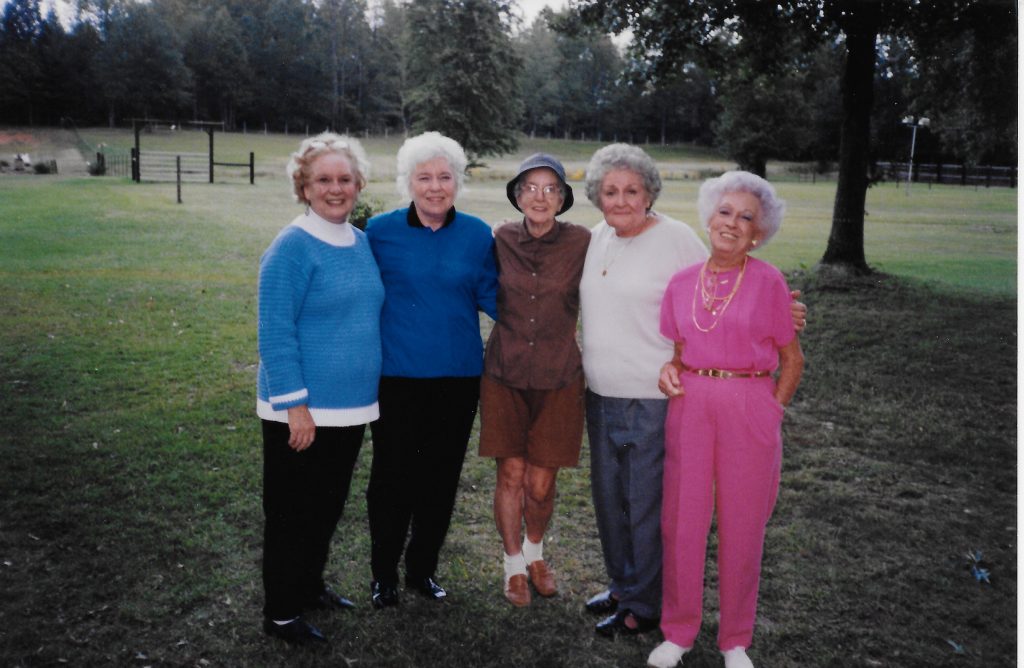Camille Lundeen. 1925-2017
“Yes, We love each of you, family and thank Heavenly Father daily for his goodness, his guidance and his watchful care over you. We have all been so blessed. Real Joy and happiness for us has been those times when we have gathered together with you….”
MORE TO COME SOON

My Life Story- Elizabeth Camille Helm

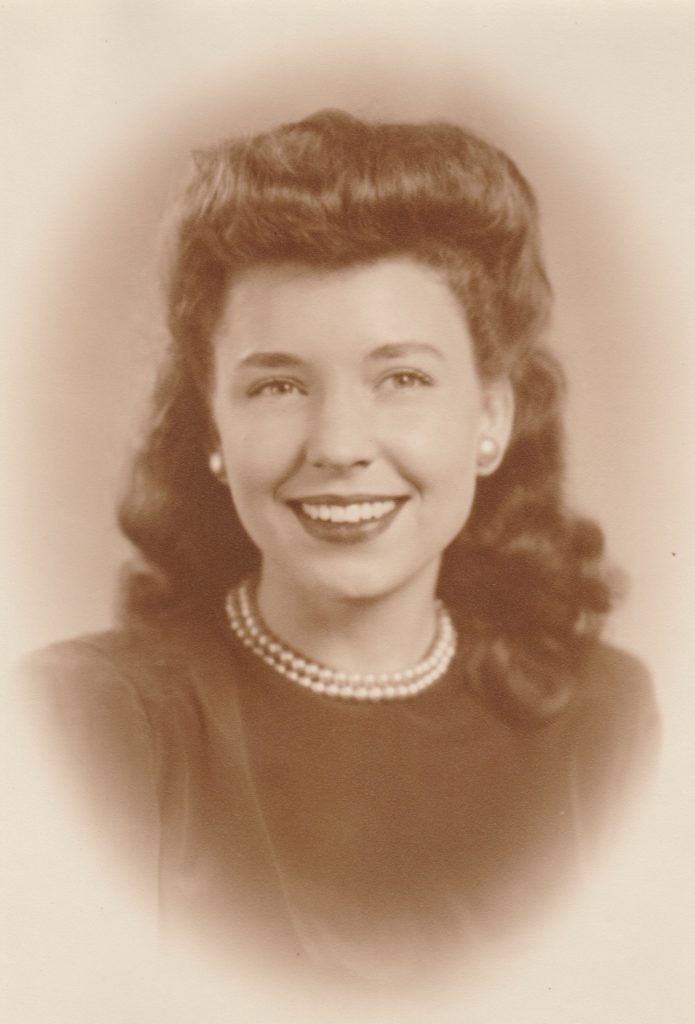
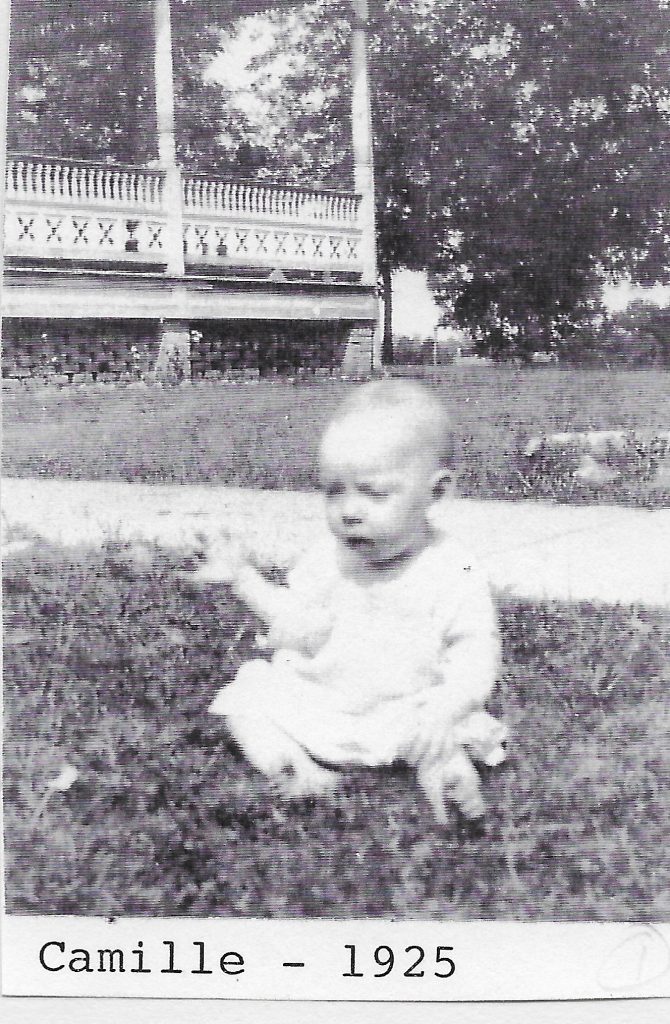

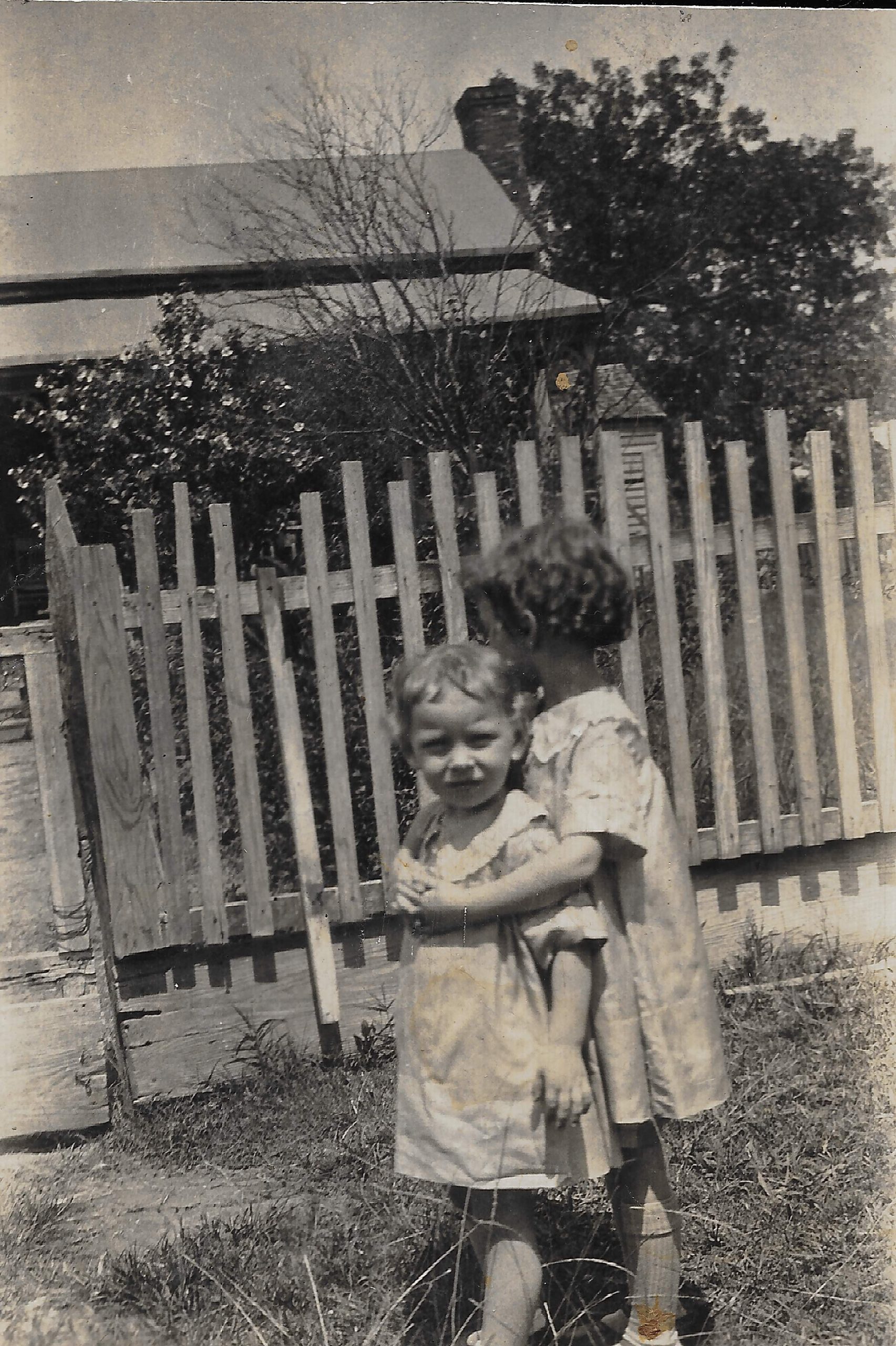
.In the fall of 1932, Mother was given title to the home that had been the birthplace of my maternal grandmother Momo (Minnie Howard Jackson), and the family moved to that lovely old colonial style plantation. My great, great grandfather and grandmother Mathew Jackson and Jane Aiken Jackson, who were some of the first settlers in the area when it was still Indian territory, had built the home in the early 1830’s had reared their families there, and had died there in the mid 1850’s. Their gravesites are in Old Scooba, the Cannon and the Turner Cemeteries just off Highway 16, along with my great grandparent Albert Emmettt Jackson and Mary Louisa Carter Jackson and her parents Clarke and Sarah Carter who had settled on land joining the Jacksons. They, too had built a large antebellum style home east and North of the Jackson plantation. This old rambling Jackson homestead nestled in a grove of crepe myrtle trees that bloomed splendidly all summer excited my imagination at the age of seven. Located about four miles east of Scooba on a dirt road two miles from Old Scooba, it had once spread over hundreds of acres and had housed many slaves, but was then only 120 acres, and it was showing it’s age. However, there the beauty of the wide open spaces, I first felt a closeness to Heavenly Father and to His creatures, and there I realized His greatness and goodness.
The old rambling, colonial style home, showing its age at this point, was nestled in a charming grove of crept myrtle trees that bloomed splendidly all summer, excited my imagination even at hte age of seven. It was here in these wide open spaces, that I first felt a closeness to Heavenly Father and to His creatures.
I recall taking walks in the wooded areas, drawing water with a bucket on a pulley from the old fashioned round brick lined well (or cistern as we called it) and drinking from the gourd family drinking cup that always hung on the arch; bringing cows home from the pasture at sunset; being frightened by the thunderstorms and the lightening struck many trees around the home; going blackberry picking with Mother for canning; heating the old, very large, black cast iron pot in the backyard for boiling clothes on washdays; bringing in the eggs; being joined by Daddy for hickory nut hunts through the nearby woods on an occasional Saturday; picking persimmons from the two trees on the grounds and eating them by the dozen; riding the school bus four miles each way daily to school; and East egg hunts at the home of friends about a mile down the road. Each of these things bring a whole book of memories for me.
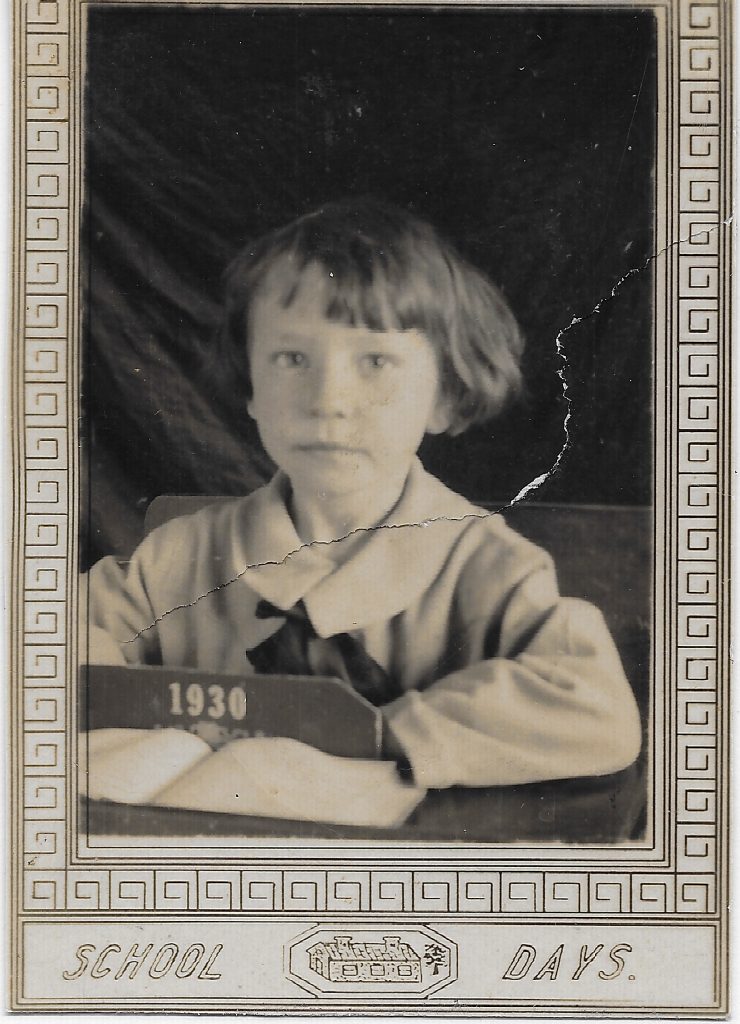
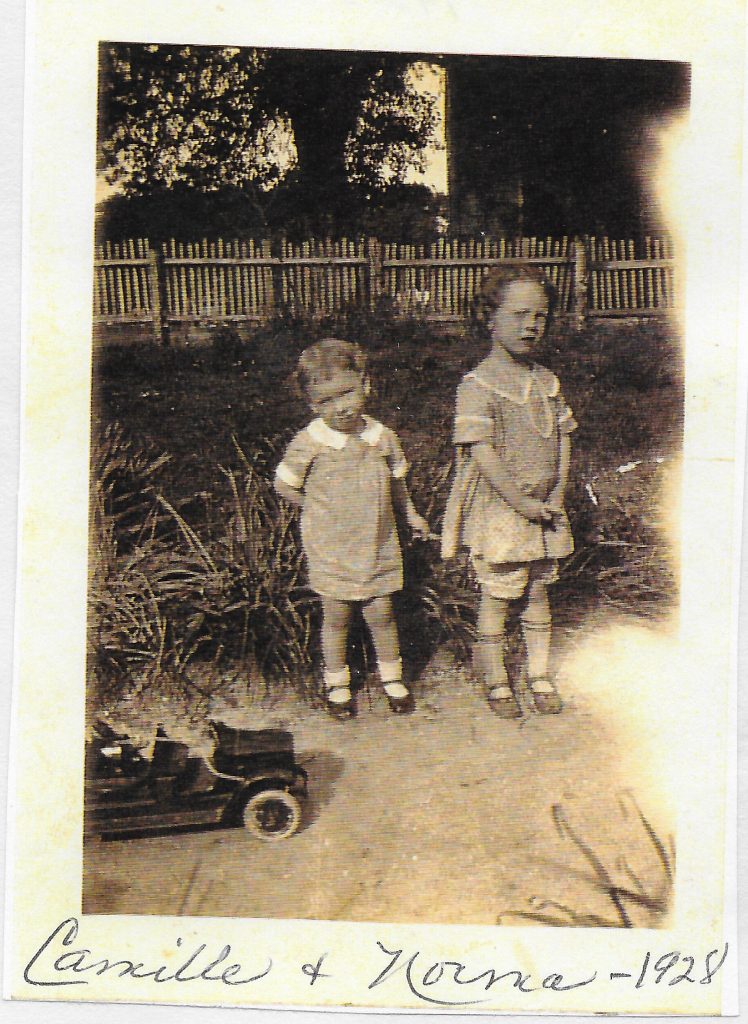
Even by the standards of the 1930’s, conditions at our home were primitive. There were no modern conveniences: no electricity, no running water, no indoor plumbing. Our daily routine was shaped y these deficiencies and by what we did not have. Yet, we children didn’t know what we didn’t have and were, therefore, delighted and entertained by so many beautiful events in nature. We read and did our homework by kerosene lamps, went early to bed, arose while the dew was till on the grass, cooked on a wood burning stove, and heated rooms with fireplaces.
We children slep upstairs where fires were seldom built. I remember winter mornings when the chill factor was about zero and the wind blew through the cracks in the walls and the floor. We would run down the stiars that led outdoors and then run through the open hallway to the master bedroom- which was also the living room- to dress by the large, warm fireplace. I still remember the feel of warm clothing heated on chairs near the glowing fire.
Some of my fondest childhood memories are of running over the rolling hills, of wading in the small stream that ran through the pastures and catching crawdads, and of fishing in the two ponds full of water moccasins that often sunned themselves on the banks. In the innocence of youth my sister Norma and I never felt boredom even though we lived at least 1 ½ miles from the nearest neighbors and miles from town.
Mother worked hard, we all did. She raised almost everything we ate in the garden, and she cooked and canned and sewed all of our clothes – many of them hand me downs. Water was hauled in buckets from the cistern and heated on the wood stove for the Saturday night bath in the kitchen in a tin basin. I remember complaining about my sister Norma’s and my afternoon chores of loading the woodboxes by the cookstove and fireplaces and milking five to seven cows before school. I complained bitterly about having to churn the milk, about taking up the butter and molding it into patties for the table, about having the job of filling the oil lamps, trimming the wicks and cleaning the soot chimneys. But my complaining never ran deep because I realized that Daddy would need to leave for any work that he could find very early in the morning and return after dark, and that Mother could not handle all the work alone. We helped her in the garden and helped prepare the fruit and vegetable for canning which hundreds of quarts. ….
Both Norma and I took piano lessons from Mrs. Carter. One hour each day was set aside for practice;
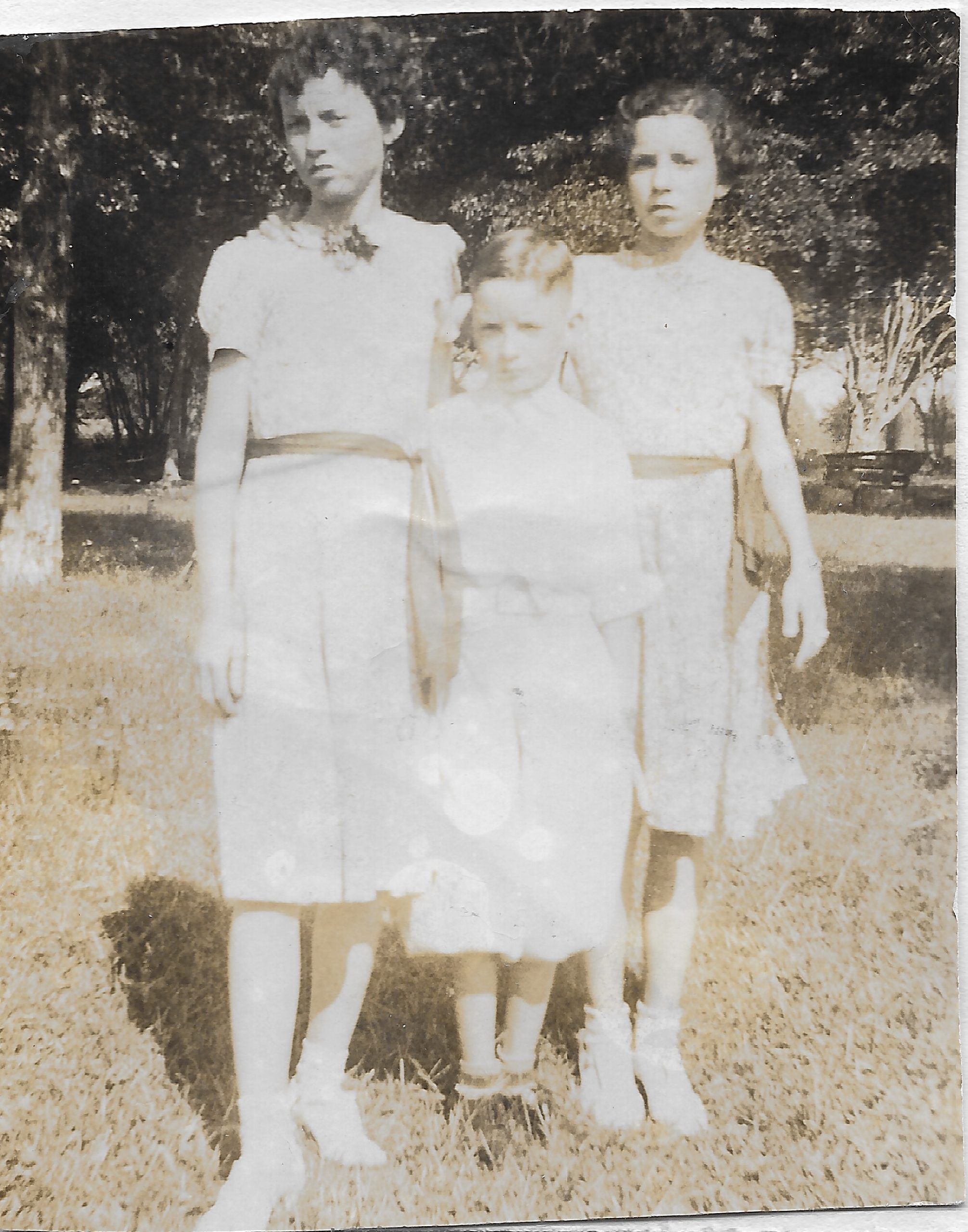

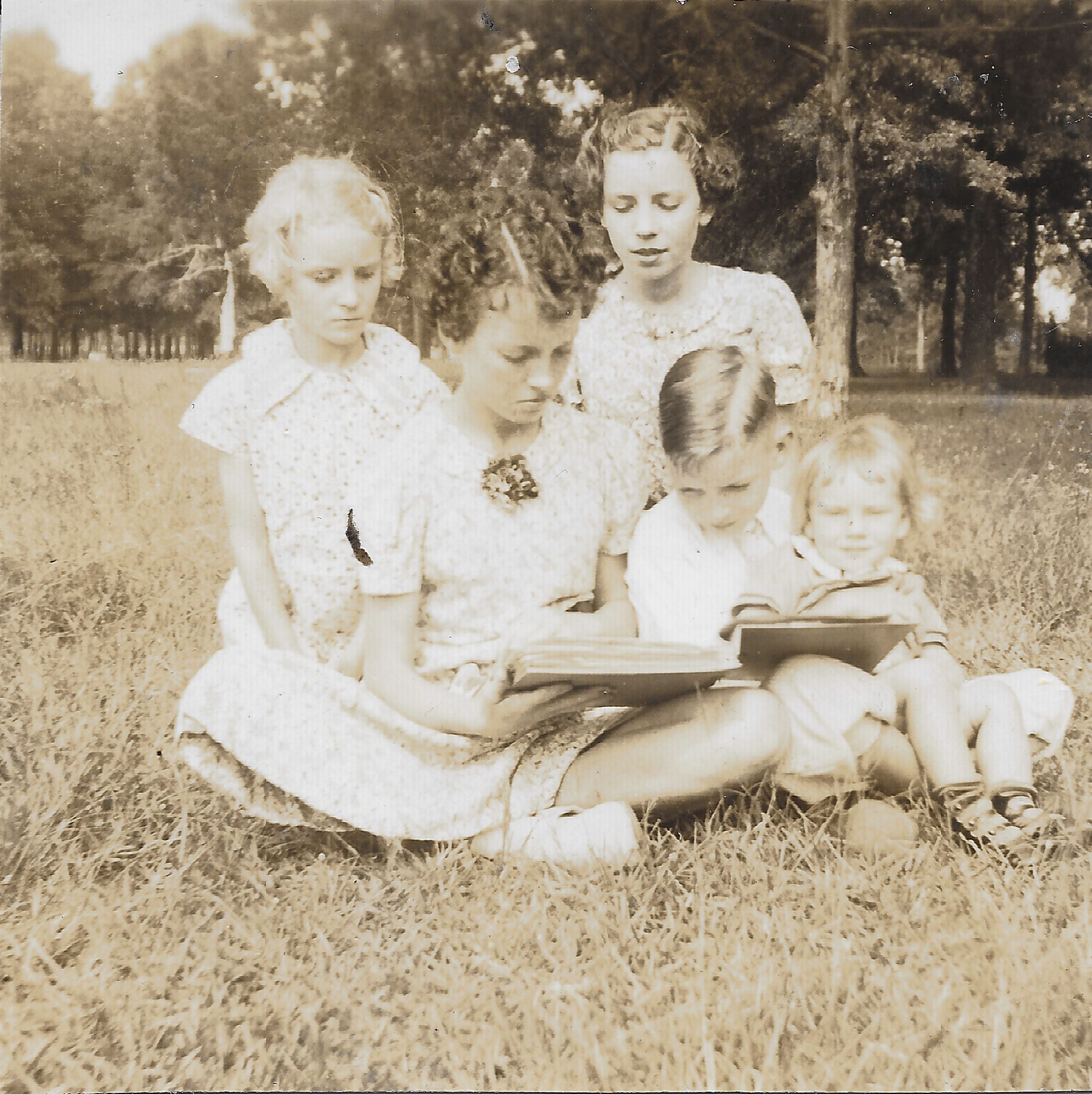
Radio was still being refined and good listening was hindered somewhat by much static. Since we had no radio, we often went to Momo’s house to listen, especially on Wednesday nights, for the Hit Parade where the ten top musical hits were played weekly. Television was unheard of at that time.
On July 23 , 1935, my youngest sister Carolyn was born. … It was about this time that Norma and I were baptized and became members of the Methodist Church with the minister dipping a rose in a glass of water and sprinkling it on our heads. When mother and Daddy married, Mother joined the Methodist church at Daddy’s insistence in order to keep the family united in church attendance. …..Daddy was struggling to make a living, as were many others around us. The depression had reached it’s lowest level between 1931 and 1933. Franklin D Roosevelt had become president and he immediately began programs to reform finances and business. Daddy worked on one of the president’s “New Deal” programs.
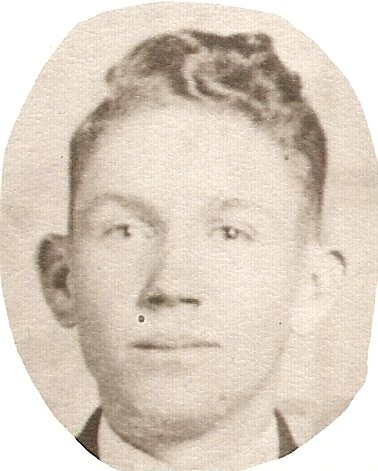
Over the years Mother and Daddy had allowed barriers to develop and widen between them causing much conflict and sadness in the home. So in the fall of 1936, Daddy left Mother and the four of us children to care for alone. I saw Daddy only four times after that. He contributed nothing to our support. In fact, we did not even hear from him for many years.
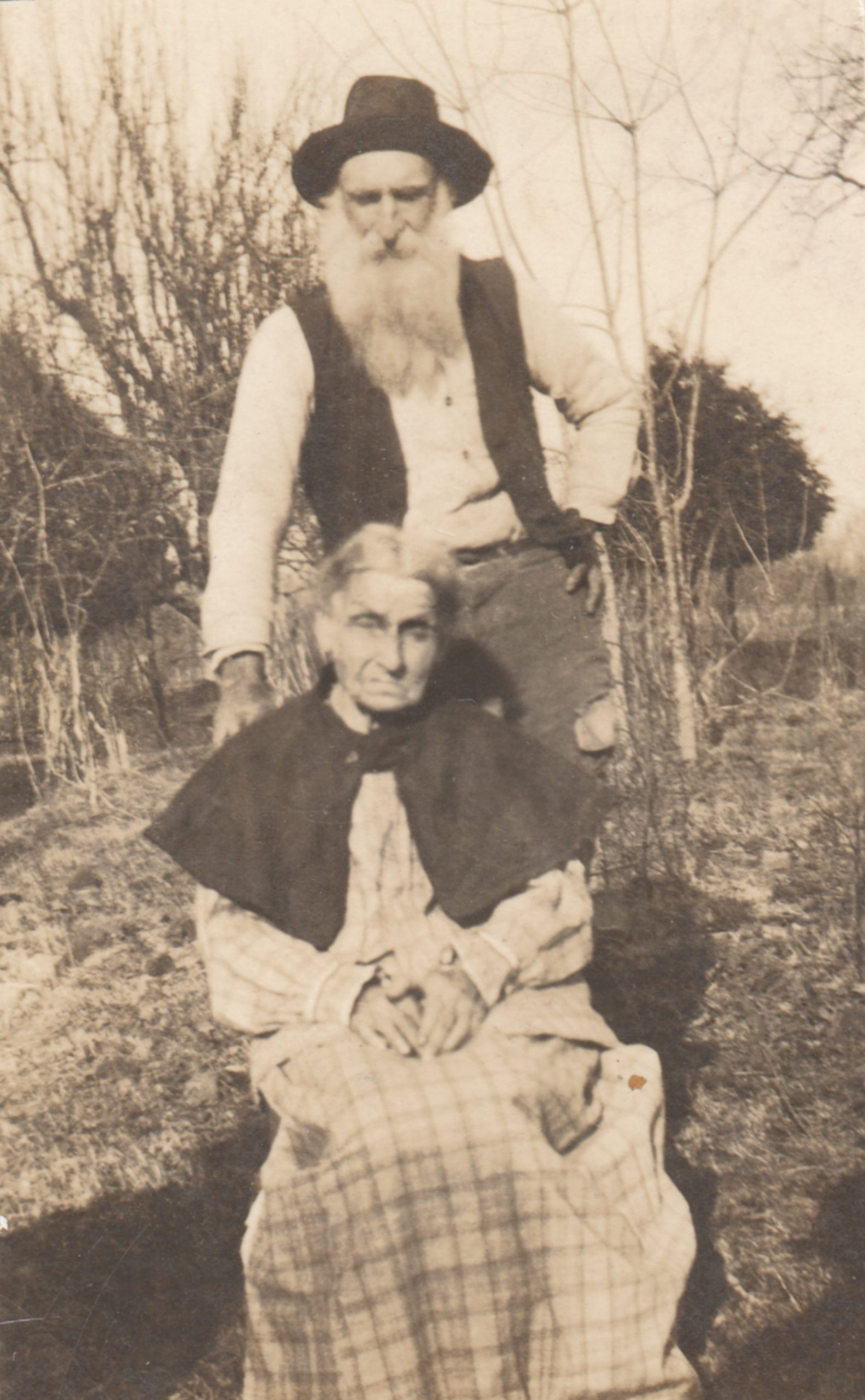
Uncle John Jackson, Momo’s brother who had lived his entire life on the Jackson plantation and had never married continued to live there after it became our home, too. He was 83 yrs. old and such a kind man. Around the base of a huge old oak tree in the back yard, he intrigued us for hours with his true , first hand stories of the Civil War,. But his death on February 16, 1939, changed the picture for us. Mother and we four girls (Carolyn was only 14 months old) were left alone now so far out in the country with no means of transportation. The house caught fire one cold winter night, and a stormy wind blew out one of the downstairs windows. It was a very difficult time for us, especially Mother. So that year, we moved in with Momo (Minnie Howard Jackson) in Scooba. (Taken from E. Camille Helm Lundeen’s Biography)
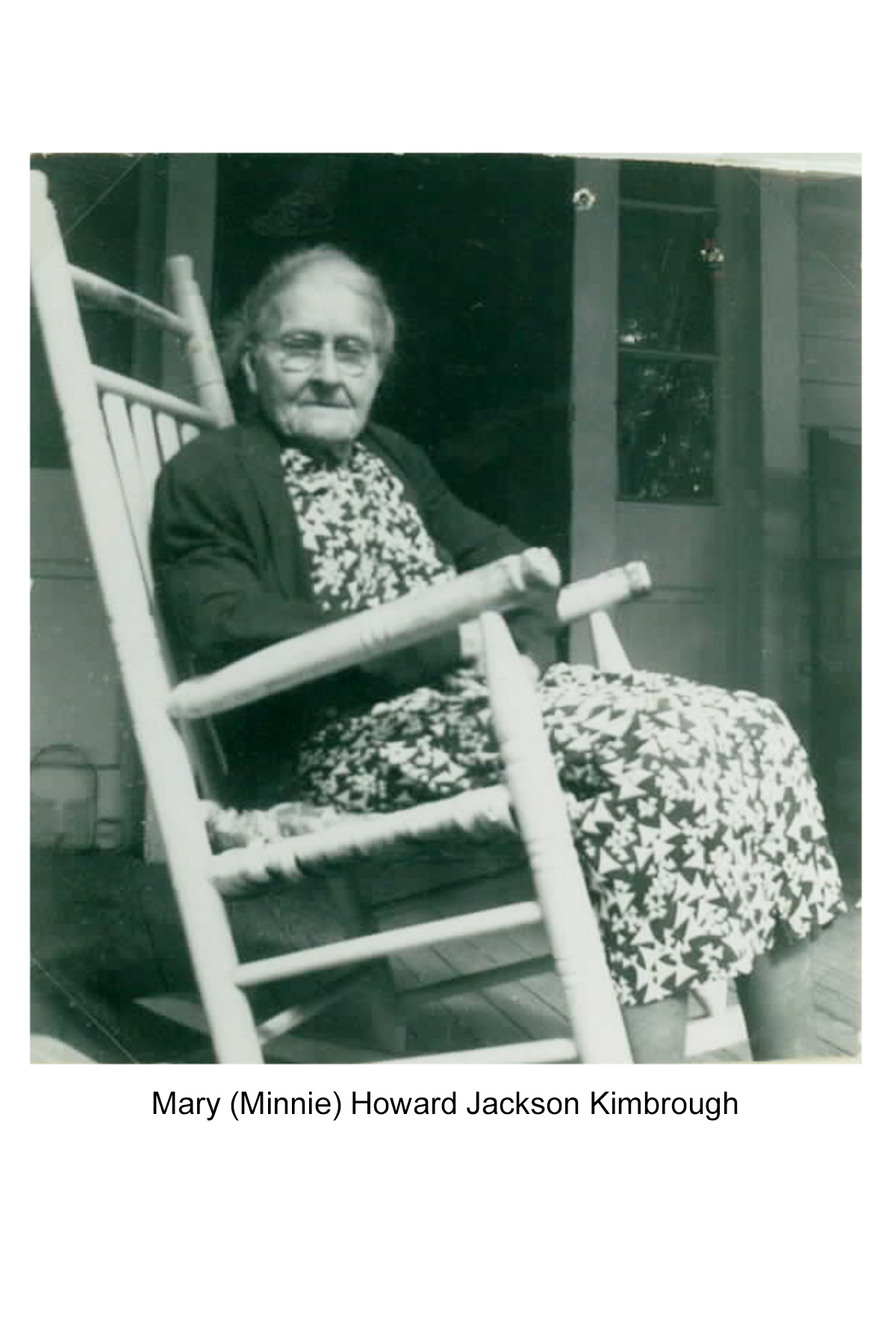
Momo (Mary Howard Kimbrough) already had our cousin Sonny living with her, so conditions were somewhat crowed. But since Norma and I were now teenagers, we like the idea of bing closer to our friend and closer to the schools. Mother worked in Uncle Thomas Kimbrough’s general store. Uncle Thomas, a devout Christian for whom we all had great love and respect, was till the Presbyterian minister in town.
Momo had luxuries that we thoroughly enjoyed. Besides having a radio, she had electric lights, as well as an electric wringer washing machine and an electric iron. Shang stayed on as the cook and house maid. However, Mother’s income was hardly suffiencient for all oof our needs and jobs were not available for girls as young as we. Son on October 22, 1939, Mother married Russell Pinson Gilbert, postmaster in Geiger, Alabama, which was only twelve miles from Scooba. Mother, Ben, and my younger sisters, Dorothy Anne and Carolyn, lived in Geiger with Russell while my older sister Norma and I stayed with Momo so Norma could finish her senior year at Scooba High School. The next year I enrolled at Livingston High School in Alabama and lived in Geiger with my family.
Living there in Geiger holds few fond memories. Our stepfather, who had lived alone for about thirty-five years, ruled, prescribed, and suggested authoritatively. Even though I had no open conflict with him, I resented his unkind treatment of my sister Norma and my brother Ben who had somewhat resisted his control. Once again there was much discord within the family. Norma, having become very proficient in secretarial science in high school, left home shortly after graduation and went to Louisville, Kentucky, where she found work as secretary and lived with Aunt Louise. I continued my education at Livingston High where I was an A student and enjoyed many good friends, and some caring teachers.
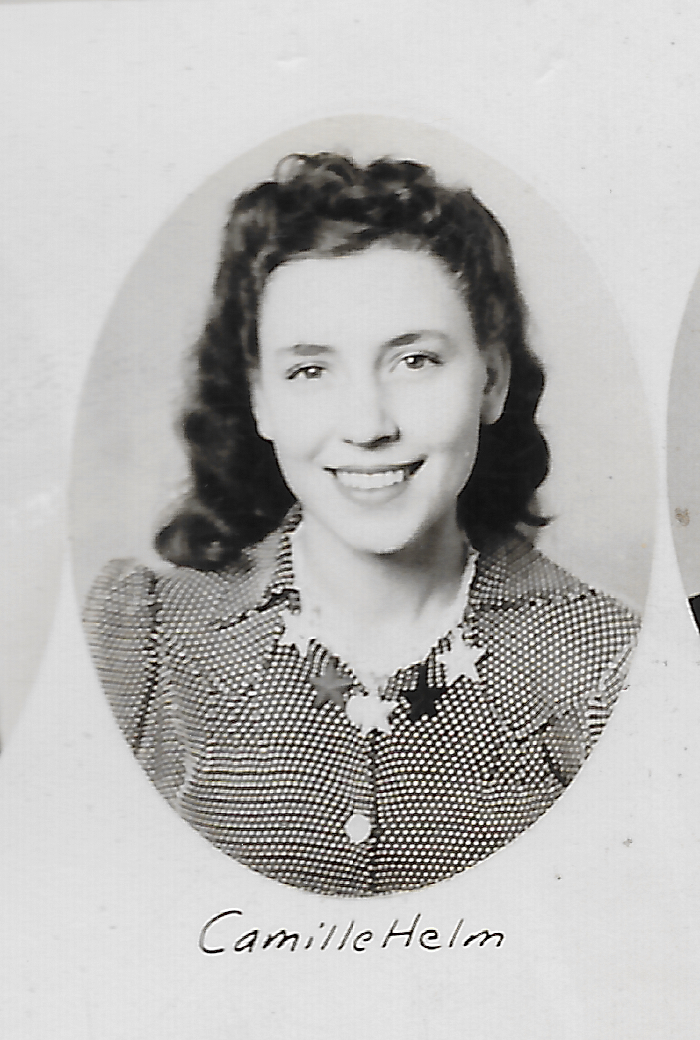
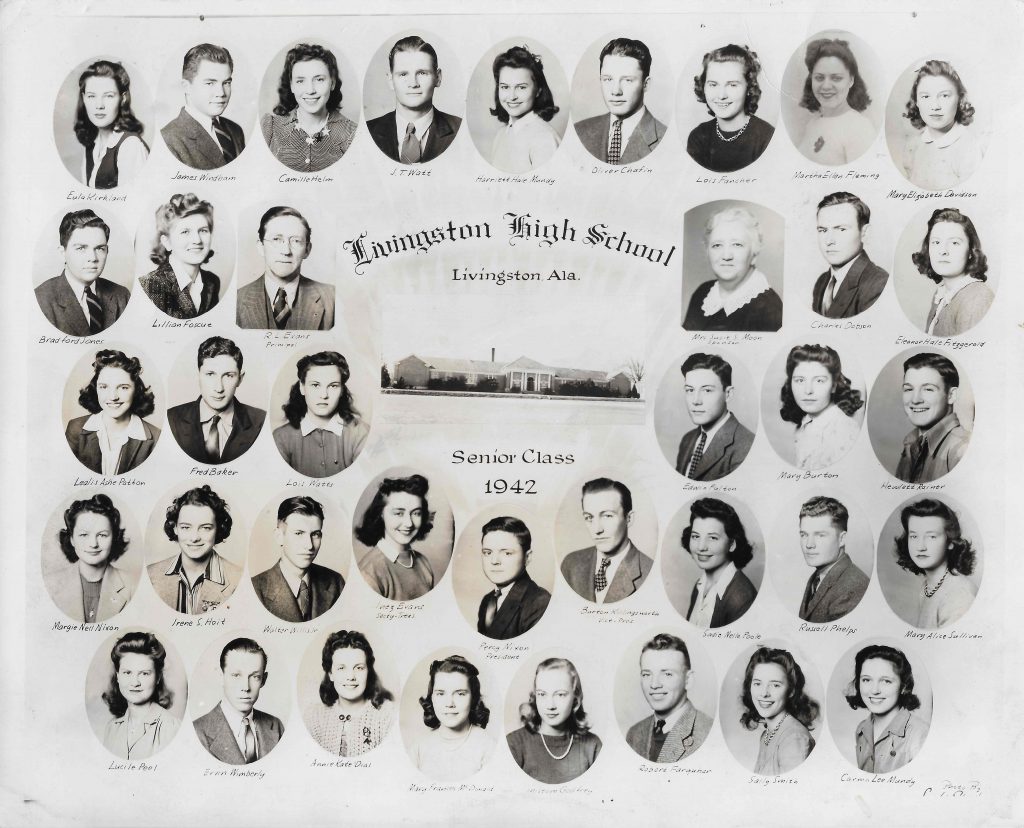
After graduating from Livingston High School, I enrolled at Livingston State Teacher’s College, While in my first semester in college I answered a call from the FBI to take a qualifying exam for employment. Within two weeks, a call came to report to Washington D.C. for work. I left college immediately, stopping in Louisville, Kentucky, to visit my sister Norma and Aunt Louise. Norma felt like a small town girl of seventeen years of age, was not ready to go alone to the big city of Washington D.C. helped me find work there in Louisville where I shared and apartment with her and Aunt Louise for a short time.
My first job was temporary typist at the Young Men’s Christian Association (YMCA). Still feeling a strong desire to further my education, I enrolled at the University of Louisville night school, taking courses in chemistry. One of my instructors there recommended me to a friend who needed a chemist in a defense paint lab, Reliance Varnish Company. I was hired immediately. I then had enough money to move from the crowded apartment to the YWCA or Young Women’s Christian Association, where I served on the council for two years.
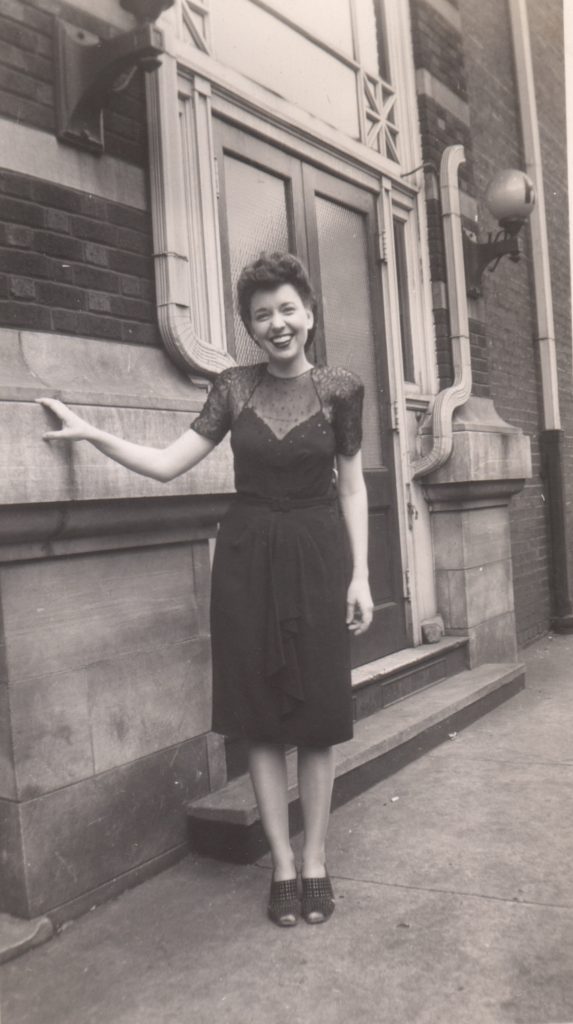
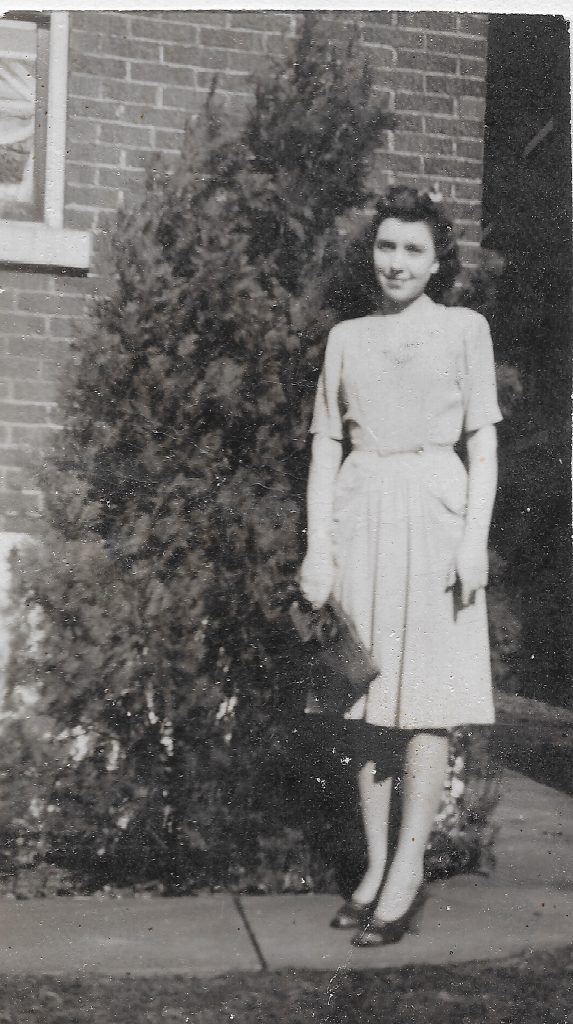
For the first time in my life, I had my own private room. The location in downtown Louisville at Second and broadway was ideal for someone without a car. The streetcar, taking me directly to work, topped in from of the YWCA and one of the two United Services Organizations (USO) had an office and service club next door. I enjoyed immensely the dances held for the 70,000 Army, U.S. Air Force, and Navy soldiers stationed in and around Louisville. In groups of one hundred or more, we girls who had been interviewed and carefully screened, traveled by bus to Fort Knox, Kentucky, about thirty miles outside the city, to dance with the G.I.’s Being well chaperoned, we were never permitted to leave the huge building with the soldiers nor to be taken home by any of them. The ratio at the dances was about ten boys to every girl, so we received much attention. I, however, was not looking for a mate. After observing and enduring much marriage discord that had negative effects on our family, I was determined to be cautious, careful, and choosy– or perhaps, never to marry. Besides, with the warm, friendly atmosphere at the YWCA and several girlfriends, I felt very content with my life.
World War II had begun in the spring o 1939, and during that year Hitler, leader of the Nazi party and chancellor in Germany, showed the astonished world the awful striking power of his army. On December 7, 1941, the Japanese bombed Pearl Harbor and within several days our country was officially at war. Suddenly our lives changed significantly. We became involved in ration stamps for gas, sugar, and many other items, and in the labors of rolling bandages and working in other USO programs to benefit our servicemen.
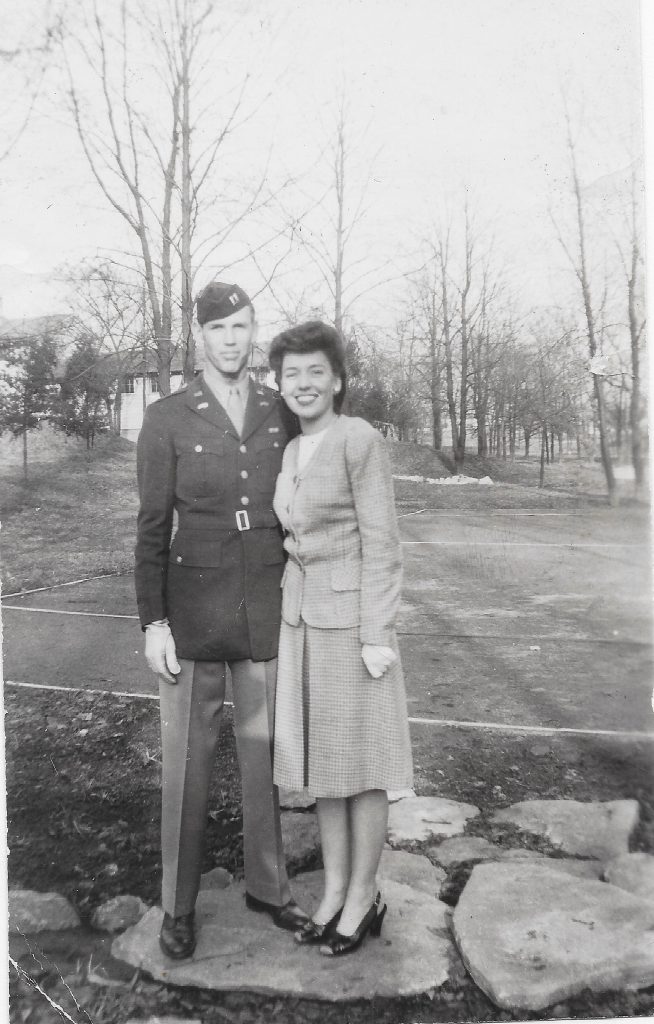
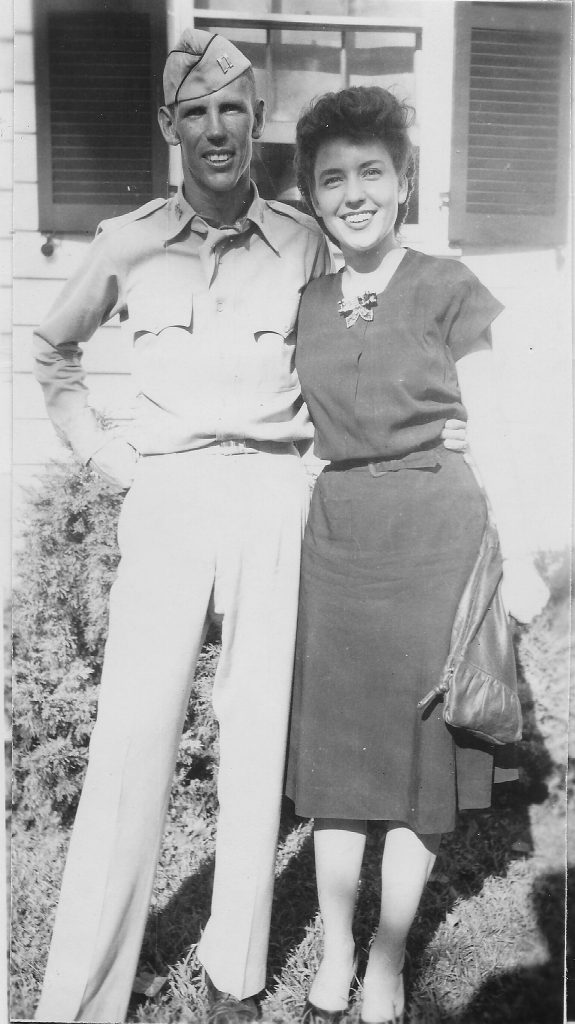
In the later part of 1944, Mary Seymour, one of my girlfriends from the YWCA who now lived on the post at Fort Knox and was secretary to a high ranking Army officer, invited me to a Welcome/Get Acquainted Party being given for a new arrival of officers. I trusted Mary’s choice for a blind date for me for she knew my preferences: tall (I was five feet xic feet inches tall), nonsmoker, abstained from alcohol, and athletic. She had just the right choice for me, one First Lieutenant Howard Kenneth Smith. However, because I could not attend the beginning festivities on Friday night but was there for the Saturday evening get-together only, Howard– or “Smitty” as everyone called him, had chosen a lovely blonde young lady who also worked at Fort Knox and with whom he had paired the previous evening. The only officer left for me was a short dentist who fortunately had a terrific sense of humor and was a good dancer.
But, as fate would have it, Howard foud many opportunities throughout the evening to speak with me. He even asked to take me back to Louisville the following day, which was Sunday. I was impressed by him: his tall stature of six foot three inches, his handsome, clean cut appearance, his self-confident, unpretentios, respectful, courteous manner, and his love for the outdoor. He had his tennis rackets in the back of his Pontiac coupe.
We saw each other often during the several months that he was stationed at Fort Knox. During this time, I was hospitalized due to an injury to my left index finger by a paint spray gun. Howard brought by a dozen red roses and called often during my convalescence. This was a blessing because my sister, Norma had been transferred as a teletype operator to Washington D.C. I missed my family closeness at this time.
Howard was then transferred to Camp Hood, Texas. We maintained a weekly correspondence with regular phone calls. I moved to a private home on Cherokee Road that we affectionately call the “Hanson Hen House” Twelve girls lived there along with the landlords. Mr. and Mrs. Hanson.
President Harry Truman announced on August 6, 1945 that an atomic bomb had been dropped on Hiroshima, Japan, and on September 2, 1945, World War II was over. Captain Howard K. Smith, who had been promoted in rank, paid me a visit en-route to Fort Bragg, North Carolina, where he was being transferred. We discussed marriage briefly, but because I was of my experiences growing up with my mother’s marriages, there was an uncertainty or nervousness about my commitment to such a sacred, permanent contract.
Howard and I did eventually finalize our marriage plans through the mail. Howard learned that he could get a two week leave of absence for a Honeymoon during the later part of November 1945. In spite of my arguing the arrangement for a wedding would take more time for me to prepare for, we agreed on November 22, 1945. The plan was eventually finalized that I would come to Fort Bragg on November 21, and we would be married there in the Post Chapel on the appointed date in order to have more time for the honeymoon. Since I was not so assertive in those days and Howard was so convincing, I accepted his schedule.
Albeit by train and with my own funds, I arrived in Fort Bragg, North Carolina, at the appointed hour– two months before I was twenty years of age. The afternoon was a busy one with pictures to be taken, a trip tothe county clerk’s office for the marriage license, blood tests, rings to be sized, and other arrangements. Howard ha selected a lovely Tiffany design engagement ring that held a beautiful diamond he hd purchased some years earlier and had worm himself in another setting. He had already arranged the preparations for our housing, the ceremony (to be performed by the Post Chaplain), and the witnesses.
Read their engagement story through the letters from Howard to Camille.
On Thanksgiving Day, November 22nd 1945, Howard and Camille were united in Holy Matrimony with Camille’s friend Mary Seymour and Howard’s good friends, Glen Byrnes and his wife Helen acting as witnesses. Camille wore a dressy dress with a beautiful white orchid Howard had given her, and Howard wore his Captain’s uniform. The double ring ceremony ended as we knelt, joining our right hands with the Chaplain laying his right hand on ours ad as he blessed us with these words:”The union in marriage: sanctify and bless you, that ye may please Him both in body and soul, and live together in holy love until life’s end. Amen”
No family on either side was present. Howard’s mother had passed away September 1943, while he was in the Army. Camille’s stepfather found many reasons why it was impossible for her mother to attend, one of them being Russell P Gilbert Jr. was too young to travel being 5 years old.
We left immediately following the ceremony for our honeymoon in Howard’s 1940 Pontiac, traveling and seeing many sites in Washington D.C. and New York.
A rented room in a charming house in Fayetteville, North Carolina, just outside Fort Bragg, was our first home, but for only a short time. Howard, having asked for a discharge and turning down an offer of being made Colonel if he would make the Army a career, got orders to report to Camp Atterbury, Indiana. There he was honorable discharged after three years and eleven months duty, and was given a termination date of February 18, 1846
Together we began the trip home, which was to be California by way of Geiger, Alabama– the Helm/Gilbert residence, for a short visit with Camille’s family where they would meed Howard for the first time. Then as we drove across the miles, Camille became ill with what we thought was the flu. However, when the nausea became suffienctly troublesome, a doctor’s appointment was scheduled while visiting friend in Little rock, Arkansas. The diagnosis, pregnancy. Our surprise and joy was diminished when the unsympathetic but realistic doctor told us that because of the many miles yet ahead the problem would get worse.
Our destination was Big Bear Lake, California, forty eight miles from San Bernardino, California, where Howard had invested monthly during his time in the service in the Bay View Trailer Park and Sales with his sister Lucille and her husband Jack Mitchell. We arrived there in mid-February 1946 in a beautiful snow storm. That winter the snow banked around the houses were about 6 feet, making it necessary to wear snowshoes. And while Howard found life pleasant with his family, and enjoyed some skiing, ice skating on the lake, hunting and fishing with Jack, and building the business, Camille had many reservations about living in the same house with not only Lucille and Jack, but Margie, his half sister who was also pregnant, and her husband Otto Gunderson, both of whom had been recently released from the service, too.
Then on Septemer 22, 1946 we rushed down the mountain to the hospital where our beautiful Pamela Jean Smith was born. We were proud parents who enjoyed watching her grow. Margie’s baby Carol had been born in July, so we had two babies in the home.
When Pam was about 4 months old, and Camille’s sister Norma was expecting a baby, Camille took this opportunity to get away from the crowded (unhappy for her) circumstances in the home. She was gone around 2 months before Howard came out to attend a Basic Infantry Course for officers at Fort Bennings, Georgia. The schooling for Howard was rigorous, it being winter; however he enjoyed it. Upon completion we returned to California once again visiting family all along the way.
After we returned to Big Bear Lake, Howard Kimro Smith was born on March 5, 1948. Camille wanted his middle name to be Kimbrough, after her mother’s name, but Howard won out with Kimro.
At this time, we realized that the business adventure in Big Bear Lake was not proving successful, so after losing all of our investment, we packed our two precious children and everything we owned into our faithful Pontiac Coupe and came down to Los Angeles, determined to make a go of it on our own.
Camille promised Howard that she would make any all all sacrifice required if he would enroll in college to pursue his talent in art, or whatever he desired. Howard was permitted part-time hours after school to work for the Mutual Liquid Gas Compamyas dock worker. And when he got home, Camille worked evenings at a local drug store. So, with careful budgeting of our funds in a fishing tackle box, along with much self-denial, me managed to eke out an existence on our meager income.
Unexpected Miracles
Then tragedy struck. Howard Kimro(Kim), who was now almost five months old became very ill during evening hours with a fever, severe cramps, and heavy perspiration. Very uneasy we spent most of the night by his crib to see if there would be any break. Just before daylight, we drove to an emergency clinic where the doctor’s diagnosis was poliomyelitis (Polio). Unknown to us there was an epidemic of it in Los Angeles at that time. We were instructed to take him to the Los Angeles General Hospital immediately where we stood in line to have him admitted. We were informed that we would be quarantined. What a heartbreaking experience for us to leave our baby son, whom Camille was nursing– leave him screaming and reaching out to us in a room with twelve cribs filled with other children crying! Heartrending to say the least.
We were told Kim was the youngest child ever to get the disease at that time, and we were given little hope that he would survive. On our way home, Howard fortunately took time to call his friend Joe Gibby at school to inform him of our sad state that would prevent him from attending school for some time because of quarantine.
The big red quarantine sign on the door saying we were not to leave the home and no one was to enter without permission, prevented our getting to a phone to get word out. We were despairing and forlorn. That evening at 7:00pm, a miracle happened. In answering a knock at the door, Bishop Bybee introduced himself as the Bishop of our ward, the Centinela Ward, and informed us that he was permitted to come inside. He reported that he had been informed by brother Joe Gibby of our disheartening situation and offered to go to the hospital with another Elder to administer to Kim that very evening and asked permission for the ward embers to pray or Kim the following day, Sunday. He offered to bring any desired groceries to the home, as well as furnish any needed financial help.
This was Camilles’s first introduction to the LDS Church in action. She sat quietly in the background listening to the Christlike charitable deeds proposed by this kind Bishop. Howard expressed deepest appreciation to the Bishop of his responding so quickly to our needs., and for his kind offer to bless Kim and to pray for him, along with the ward members. We prayed together, the two of us wit hPam joining in. Camille’s testimony was “I was impressed for never before in any church I have attended have I witnessed such Christian concern. I promised the Lord that night that if Kim recovered, I would seriously investigate the LDS Church.”
We visited the hospital as often as permitted, standing ten feet from the crib as instructed, with Kim at first crying as he reached out to us. A very difficult period, but we were thankful forour faith that all was in the hands of the Lord. Then, what a blessing it was when Kim, after only eight days, was permitted to come home where we continued, with the help of a nurse, his treatments. Prayers of the Saints, and ours, were answered, for Kim has never had any after-effects from the disease. And because Howard was permitted to return to school and to his part-time job almost immediately, we were able to meet our financial obligations without help from the Church.
As often as work permitted, we attended the Centinela Ward. But because Camille was accustomed to complete silence and reverence in church, much coming and going and noise in the chapel created a spiritual, mental block for her, however, it was obvious that the family enjoyed attending church together, and that was important.
Howard again applied and was approved for Officers Advance Infantry Training Course at Fort Benning, Georgia. Since we were expecting another little Smith in October, and Camille was attempting to keep her job selling Blind Made Products by phone, to supplement our meager income, it turned out to be a hard unpleasant three months. Nevertheless, with the help of our calm, nondemanding three year old Pam, our good neighbor Maurine Hansen and blessings from our Heavenly Father, the family survived that long hot summer.
I, Camille feel to bear testimony at this time of the influence Maurine Hansen had in helping me realize my divine potential. She was a true Latter-day Saint who demonstrated the inner goodness of people in the Church, as did her husband. While Howard was away, she, knowing my taste for watermelon during those hot days and my having no way to get one home from the market, on several occcasions brought over a large, cold slice of melon on one of her loveliest plates. It was a most appreciated kindness for a wilted spirit.
Also, one evening as I was putting Pam to bed, I noticed the face of a man pressed against the window. Terrified, I grabbed Howard’s 22 rifle- knowing nothing about how to shoot it, but using it for a bluff- ran across the court to the Hansen’s residence, knowing that Maurine’s husband was an FBI agent. he opened the door, saw me holding the gun and started laughing as he commented, “Are you a pistol packin’ Mama?” Kindly, he walked the area with me and then told about our neighbor “peeping Tom” who was the father of one of Pam’s playmates and had served prison time for being a child molester. Pam only ever played with this friend at our home under a watchful eye. But after this incident he always referred to me as “the pistol packin Mama.”
How grateful, relieved and overjoyed we were when Howard returned just two weeks before Kenneth David Smith arrived at the end of October 1949.
Upon Howard’s graduation from Frank Wiggins Junior College in May 1950, he worked in commercial art with Don Douglas a practicing artist in the field of advertising in Hollywood. It was a wonderful experience working with Don and Howard learned much there. Yet in Howard’s words, “I learned that commercial artist have a tough row to hoe since the hours are long, the pay quite low, and competition is intense.’ With a family to support, our income of $160.00 paid only once a month was unhappily inadequate.
So Many Changes..New Home-- New Last Name
However, during this comparatively brief association with Don Douglas, we were able, with his help, to make the necessary arrangements for purchasing a three bedroom track home in a new development in an San Fernando Valley. This $9,000 track home was located in a lovely old walnut grove with one huge tree by the front door just perfect for small climbers, and another that spread over the backyard. It was located on Wish Ave.
In November 1950, our new address became 7457 Wish Avenue, Van Nuys, California. It didn’t take long for Howard to transform our track home into the most attractive one on the block as he: made a planter across the front of the home; laid a beautiful wide, brick welcome walk to the front door; split discarded telephone pole and fashioned a rustic fence for the perimeter of the front yard; and landscaped with two orange trees, a lemon tree grass, ivy , poinsettias, and other exotic plants. Quite a contrast for us. The first Sunday there, we kept the promise we had made to the lord and to ourselves by attending Reseda Ward in the San Fernando Stake.
For some time, we had planned to have our name changed from Smith to Lundeen, which was Howard’s real father’s name. And now that we lived in a new neighborhood, and before the children were baptized and before they started school, this seemed to be the ideal time.
Changing all records to the name of Lundeen became an involved process, but it was accomplished and Lundeen became our official name. However, some friends and associates continued to call us Smith and other new acquaintances only knew us as the Lundeens, so for years we answered to both. Fortunately the children hardly realized it.
Soon after we commenced attending the Reseda Ward regularly, Camille was called to teach the beginner class in Primary, an unusual call since she was not yet a member of the church. On June 23, 1951, Howard baptized her in the San Fernando Stake Center font. Then on July 1, 1951, Howard confirmed her, and blessed Pam, Kim, and Kenny the same day. Many ward members were surprised not knowing beforehand that our entire family had not been members. After Camille’s baptism, our determination grew to have our marriage solemnized in the temple, and our children sealed to us. The Manti Temple in Manti, Utah wa the only one near that was not closed for the two week summer closures. So after driving from Van Nuys, California to the Manti Temple, on July 31, 1953, we were sealed as husband and wife according to the ordinance of God for Time and Eternity in the House Of The Lord. And our three precious children, Pamela Jean Lundeen, Howard Kimro Lundeen, and Kenneth David Lundeen, were sealed to us for time and eternity the same day. Without question, these were the greatest steps forward our little family had taken. We shall never forget that heavenly point in time when the three of them were brought to us in the Sealing Room all dressed in white.
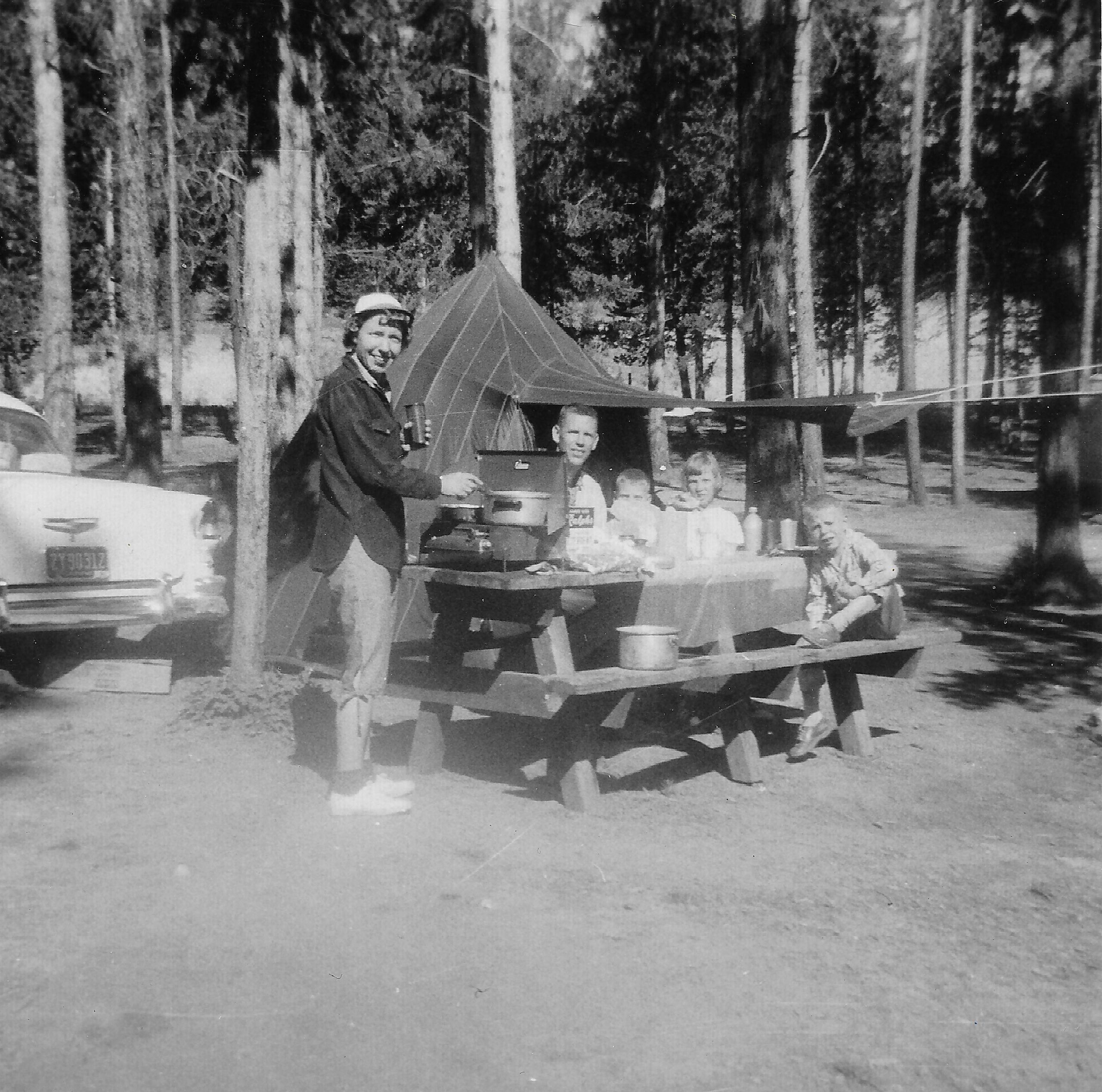
Early in our married life we started a yearly camping tradition as we vacationed in Yosemite National Park, Sequoia National park Carpinteria State park, always sleeping in our sleeping bags in our tent, and daily fishing and swimming in the rivers. The nightly lighting of the campfires, the pungent smell of potatoes and onions cooking on the fire, the marshmallow roasting, and wieners and the making of so-mores will always remain memorable for each of us. Many times Howard would be out of town on business and could join us only on weekends. And Dad’s arrival was always a big event.
In January of 1957, Howard was released as Bishop.
On November 12, 1957, Heavenly Father sent us one of those “precious souls held in Heaven” when Kris Alan Lundeen came into the world. Ken was eight years old, Kim was nine, and Pam was eleven, all at the age to fully enjoy him, and to help.
Everything in our lives was centered around the Gospel. We gathered our family each morning before school and work for family prayer, and we held our weekly Monday night Family Home Evenings that didn’t always run smoothly, but were, nevertheless, meaningful for we were doing what the Prophet President David O. McKay asked all families to do. Mostly we just had fun being together at a time when Howard was in town and had no Church meetings scheduled.
On September 21, 1960, Dr. Jennie Howell delivered our Kelvar James Lundeen. He too, was one of the “precious souls held in Heaven to come forth in the latter days to establish the Church of Jesus Christ… to go forth in the world as.. ambassador of Truth and Righteousness..” (Taken from Camille’s Patriarchal Blessing) He was a happy, pretty baby who was loved and cared for by his sister and his brothers and by his parents who were somewhat wiser now.
With Howard home some evenings now ad Pam being a trustworthy baby sitter, Camille decided to begin attending night classes at Pierce Junior College which was about five miles from our home. “My returning to school has proven to be a real blessing for our family, mine, and theirs. My English and American Literature classes, concerned with building faith and championing spiritual values, and opposing and exposing selfishness, materialism, shallowness, and all things harmful to the human personality, have given me a different perspective on life and have helped me function more meaningfully as a teaching parent. Even our conversations around the dinner table are more stimulating as we, in an effort to improve our individual vocabularies, have begun encouraging each family member to introduce and discuss a new vocabulary word as we eat together.
In January of 1967, Camille had graduated with her Associate of Arts Degree from Pierce College, so now she enrolled at California State University at Northridge. At first, she attended only mornings in order to be home when the boy returned from school. And then as they moved on to full-day sessions, she, too, attended full day. On June 1968, Camille received her Bachelor of Art degree in English and Speech, the same month that Pam received her BA Degree from BYU, a very exciting and well earned milestone. In July 1969, Camille was hired by the Los Angeles School System to teach English and speech at Lawrence Junior High School in Chatsworth, about ten miles from home. The four years there were pleasant ones. In June of 1973, the day after school was out in California we arrived at our dream home in Toquerville. In spite of the warning of California friends about moving to Utah, we felt a genuine welcome and charity from everyone in Toquerville. We had an immediate confirmation that “this is the place” for us. In September 1973, Camille opened the Educational Opportunity Center (EOC) at Dixie College. Many students entering college, especially mionorities were so deficient in academic basics, mainly reading, writing, and math, to a piont they would not succeed in college. Fortunately, for Camille, both Pierce College and the University of California at Northridge had excellent pilot programs that she carefully observed before leaving the area. At Dixie College there was a definite and recognized need for such a program, but despite committees and proposals none had been put into place. So, she was fortunate to be chose to open the EOC and be the director, and the Dixie College unit was the first of it’s kind in Utah.
We talked about our desire to go on a mission before Howard turned seventy, and he was at that time making preparations to retire from Hughes Production, we felt it best to send in our papers. This required that Camille retire from Dixie College, which she did. In September 1979 we got our mission call to Ecuador Quito Mission as Welfare Service Missionaries but later that changed to Cali, Columbia. From the beginning, it was obvious that the Lord needed us there. And from the beginning it was obvious that our language would be a barrier even though we worked on it, prayed about it, and had faith that Heavenly Father would help us accomplish what he sent us there to do.
The missionary journal goes through all the experiences we had during this period of time. There will be a link here in the future to the missionary journal.
On March 28, 1981, we received our mission release and returned home. Camille returned to teaching at Hurricane Junior High School which was only ten minutes from home. She was assigned eighth grade, thirty five students every hour for six hours. At the same time she was called as Toquerville’s Relief Society President which to a very busy schedule. In May of 1986, after deciding that teaching was too intense for old folks and that it was time to “pass the torch,” I Camille, resigned rom the Washington County School District as teacher, having taught in the district for thirteen good years, including six years at Dixie College.
Then in September of 1986, I Camille, decided to follow a long-time desire to sell real estate. I enrolled in a two week course at the Spencer and Stringham Real Estate School in St. George, took the Utah Real Estate Exam at the end of September, and passed it. I was employed by the ERA Real Estate Office in Hurricane and began my new career.
At the beginning of 1989, to everyone’s surprise, we decided to sell the Toquerville home to buy a townhome in St. George in walking distance of the St. George temple where we both served as ordinance workers. Howard was seventy-seven years old and Camille was sixty-four at the time.
Remembering Family
Remembering each of our thirty grandchildren’s birhtdays with a card and a five dollar bill has
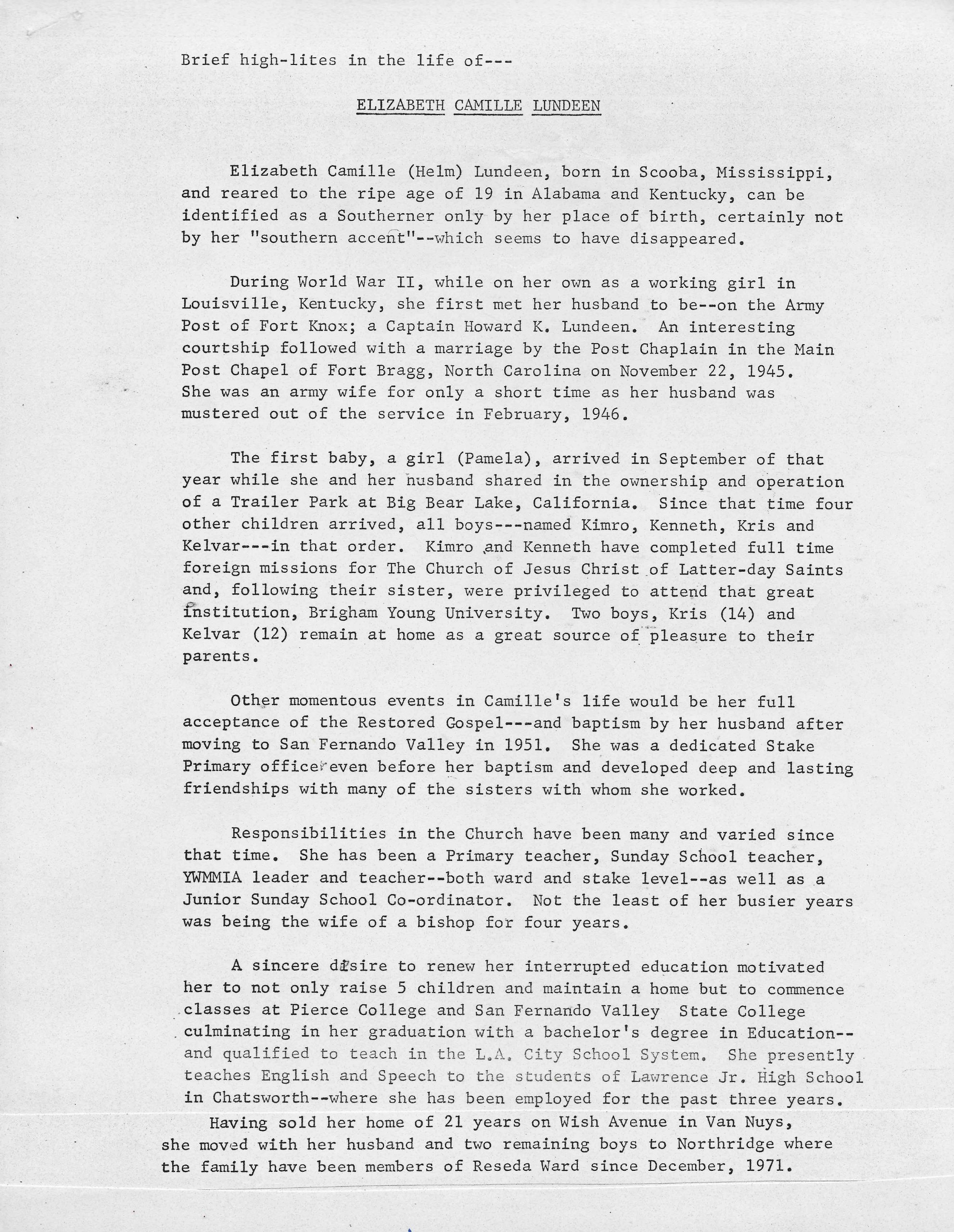
An Epistle of the Lundeen Family History Written 1971
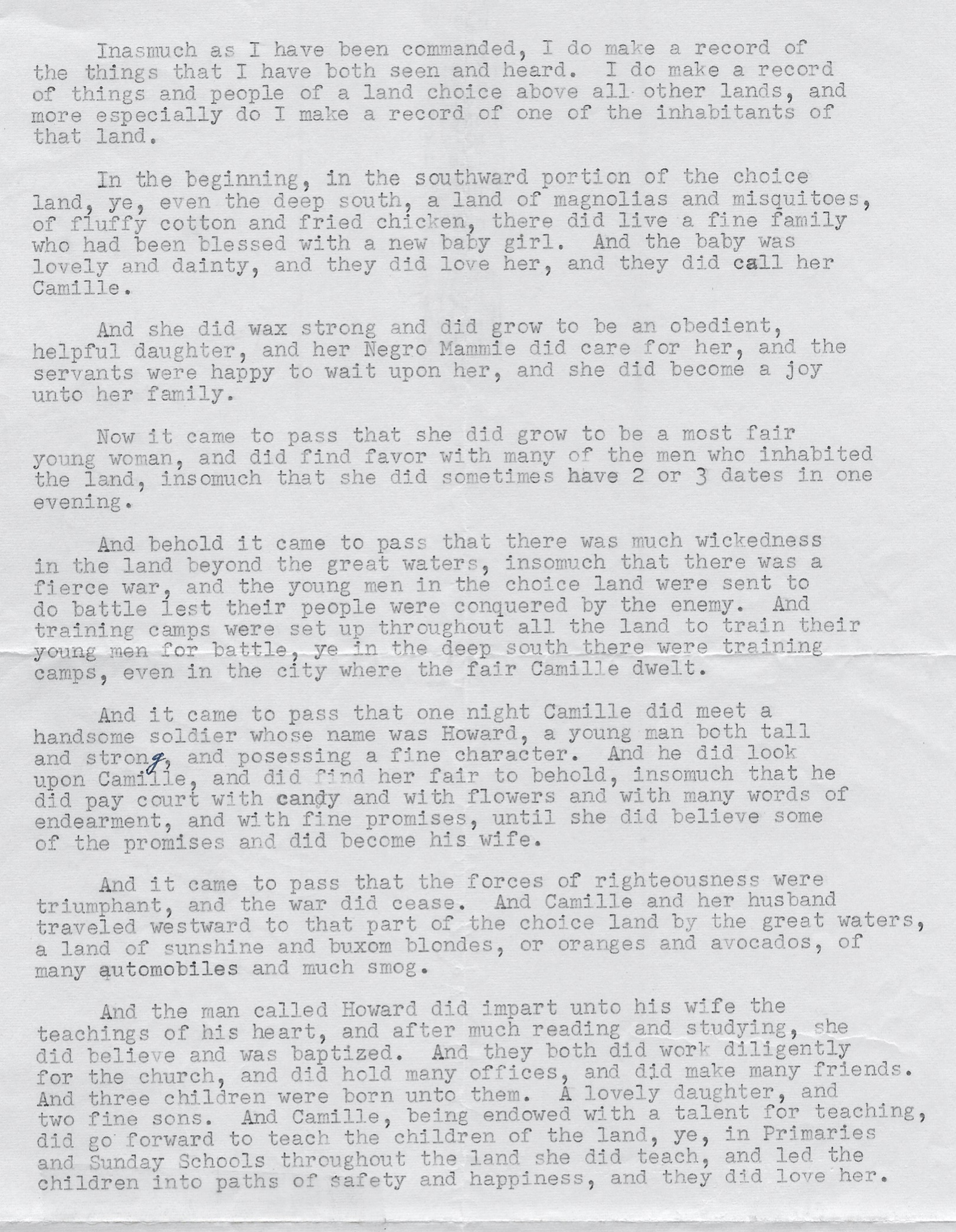
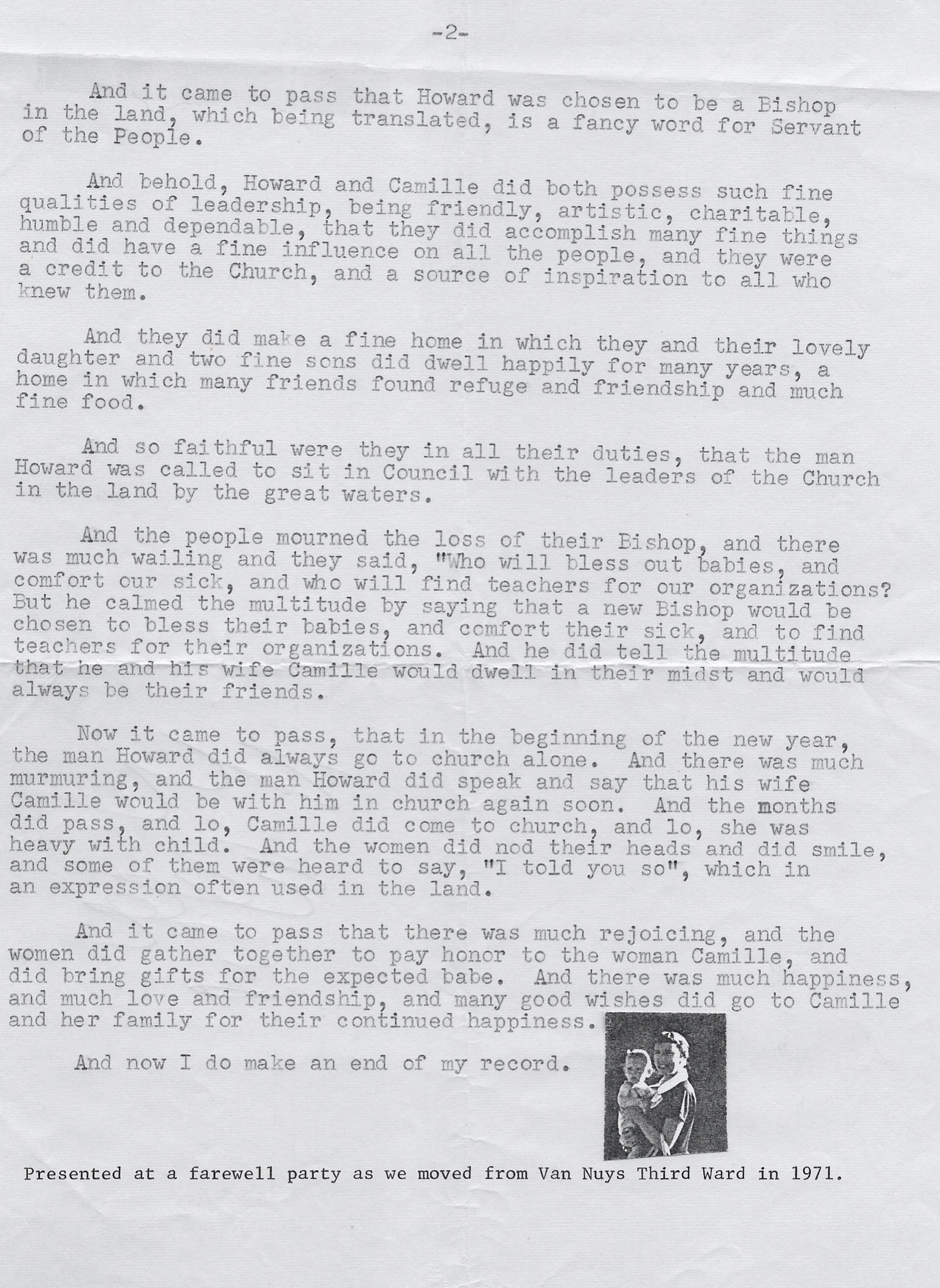
Yellowstone Family Campout 1955

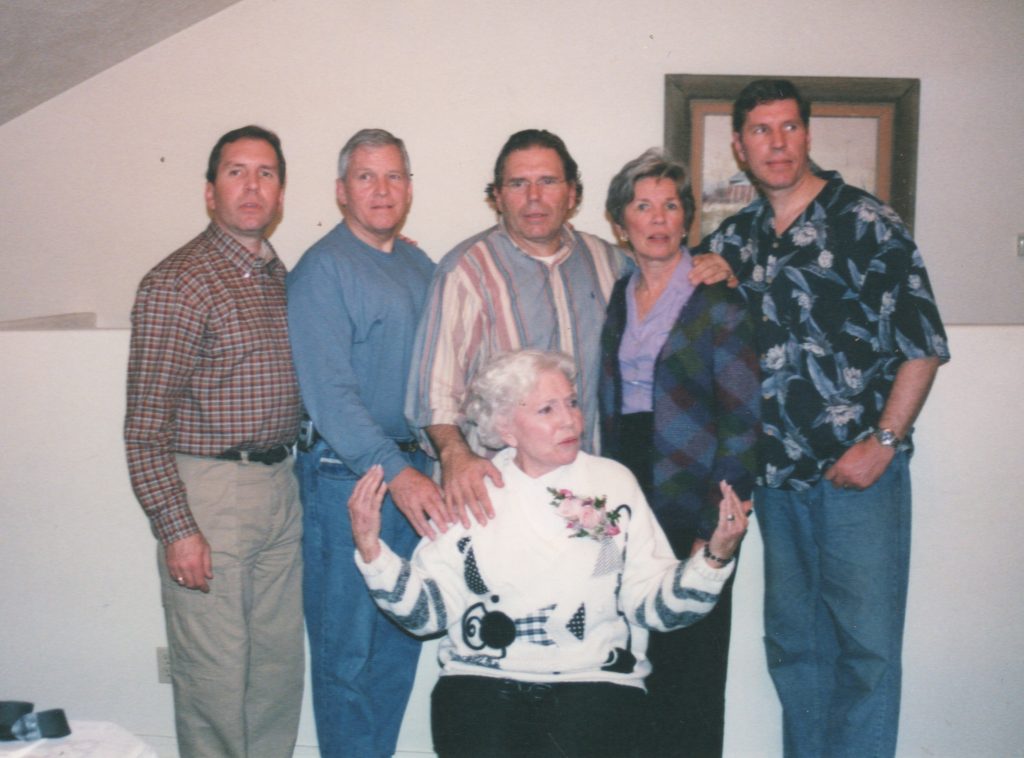
Camille Lundeen’s 80th Birthday Party… Funny family memories
Livingston High School Alabama 1942

Camille's Graduating Class- Livingston High School
Camille with her sisters
